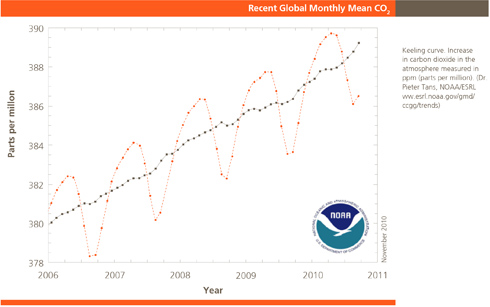 Abengoa
Abengoa
Annual Report 2010
- Activities
- Abengoa and the Innovation
- Sustainability. Abengoa’s Business Metrics
Sustainability. Abengoa’s Business Metrics
The economist Jeremy Rifkin has said that what is now sometimes called the “black” economy (in contradistinction to the “green”) - the industrial revolution driven by oil, cars and centralized energy production - peaked in the late twentieth century. Attempts to preserve the status quo only led to distortions, like the financial and property bubble that has recently burst. So it is now time to undertake a third industrial revolution: The Green Revolution.
Global warming is caused by human activity and year after year we have raised the atmospheric concentration of carbon dioxide: In November 2010, the Keeling curve exhibited a carbon dioxide concentration of 389 ppm. This poses a serious risk to the environment and to life. It is also set to deal a harsh blow to the world economy. According to the Stern Review on the Economics of Climate Change, global warming could throw the world into a slump involving a 20 % decline in global GDP. This means the economy and society would be severely disrupted for the remainder of this century and beyond.

Keeling curve. Increase in carbon dioxide in the atmosphere measured in ppm (parts per million). (Dr. Pieter Tans, NOAA/ESRL ww.esrl.noaa.gov/gmd/ccgg/trends)
The Stern Review estimates that an investment of 1 % of world GDP is needed to allay the effects of climate change. So far, however, decision-making processes have largely disregarded industry’s harmful “externalities.” Environmental and social considerations are thus rarely a factor in prevailing economic practice. But by this stage, according to the Stern Review’s conclusions, the only remaining question is how quickly the world can get to a zero-emissions economy.
Against this backdrop of far-reaching change, Abengoa is today a world benchmark in the development of innovative technological solutions for sustainable development. Abengoa and its business units’ policies and innovation strategies seek to make sustainable use of resources and raw materials so as to harness their entire life cycles. This is why Abengoa today is an international leader in many key areas of the Green Economy. The concept of “Green Economy” was coined in the midst of the present world economic crisis as part of the Global Green New Deal, the United Nations Environment Program mooted on October 22, 2008 to address the interdependence between economic activity and natural ecosystems, more specifically, industry’s harmful implications for climate change and global warming.
President Obama used the term “Green Economy” in his speech to the United States Congress on February 25, 2009 in connection with his ambitious program of energy reform. The new scheme, popularly known as “cap and trade,” aims to lower greenhouse gas emissions by 80 % by 2050 and to create millions of new, “green” jobs.
In Spain, the Council of Ministers set its seal on the new Sustainable Economy Bill on March 19, 2010. Regarded as the centerpiece of the current legislative term, the new law is intended to bring about much-needed change in the Spanish economy over the next ten years by basing it on higher value-added industries: This calls for enhanced innovation and competitiveness.
Abengoa, for its part, has been working on the challenge posed by sustainability for the past twenty years. It has honed its capacity for technological innovation as the right tool for this paradigm shift. Abengoa has invested in research, development and innovation, recruited and developed the necessary talent, and disseminated the most promising technologies on a global scale.